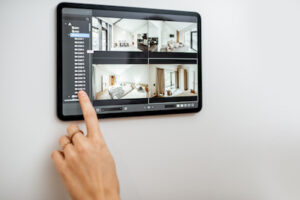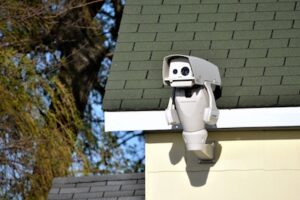7 Cool Features of a DIY Security System That Are Worth Checking Out
Did you know you can manage every electric device, including those related to home security, from your smartphone? It’s true!
Modern security solutions put total home management at your fingertips. Through the Internet of Things (IoT) and cloud computing, Big Data has developed. Because of Big Data and IoT, any electric device can be networked into the web, and controlled through a smartphone or other device. Your entire home can be managed from your phone, and that includes security. You can design a DIY (Do It Yourself) security system for your home, manage it conveniently from wherever you have internet connectivity, and keep your premises secure. So what are some useful and cool features of a DIY home security system? Here are seven great features of a DIY security system:
- Continuous Monitoring of the Premises
- The Ability to Defer Burglars in Real Time
- Live Video Surveillance Monitoring Capability
- Precise Systems Integration
- Automatic Notification of Authorities
- Internal and External Security Options
- The Very Advantageous Ability to Self-Install
So, now that you have an idea of seven great features of a DIY security system, let’s examine each one of these features in greater detail. So keep reading to find out this and more!

1. Continuous Monitoring of the Premises
So if you connect your security system with Amazon Alexa, it will continuously monitor sounds and other changes in the local environment. The way Alexa works involves Artificial Intelligence (AI) and Machine Learning (ML) networked into cloud computing arrays.
So there are around 8 billion people on the planet, and Amazon is international. The Amazon Web Services (AWS) cloud has more than a million networked servers working together like a huge brain. Think of each server as a node, or neuron, in a digital brain. Better yet, think of each server as a pixel, or the light on a billboard.
You’ve seen digital billboards in Times Square? You’ve watched them become better and better as tech progresses? Well, the scrolling text on such billboards is really hundreds of little lights being turned on or off in sequence to make an image. Pixels are the same way. Now imagine a server with more computational power than all the computers you’ve ever owned is a single “pixel” on the “screen” of a cloud computing array. That’s what you get access to.
Amazon’s Alexa is constantly sucking up data to be interpreted by this cloud array, and if you network such capabilities in with your home security, then the anomalous activity can be detected and acted upon almost automatically, and to a greater degree of effectiveness than similar solutions prior to the cloud.
2. The Ability to Defer Burglars in Real Time
With an IoT-enabled DIY home security system, you can set up surveillance that can be monitored remotely—we’ll go more into that aspect of modern home security in the next segment. Here, there’s something else to consider: sound. You can set up your cameras to automatically notify you when they detect motion.
So you’re holding your smartphone, it buzzes, you tap the screen, and you see some guy trying to break into your front door. That’s when you hold the phone up to your mouth and yell at them. At that moment you startle the mind out of your would-be burglar, and he takes off. Today, you can set such systems up to repeat a recorded message should unauthorized persons approach your premises.
It’s better to have a recorded dog barking that sounds vicious, as repetition is harder to identify in that scenario. Or you can live-time communicate. Go with what works, what’s convenient, and what you can afford.
3. Live Video Surveillance Monitoring Capability
We just touched on this: you can put live surveillance on your premises with ease if you go the DIY home security route. There are quite a few different cameras designed to network your smartphone and home together. Google has options, Amazon has options, Apple has options, and there are third-party alternatives out there as well.
How in-depth the camera you install ends up being will depend on what you’re willing to spend, and how well you can “mount” the devices. Some use solar panels to charge them, others function from a simple battery, and others can be plugged into conventional electrical grids.
You can get cameras that only send you a notification when there’s some movement, or cameras that continuously record, backing the data up to a cloud drive that you “rent” based on your needs. The quality of recorded video you can capture is up to you as well. You can go with high, mid, or low quality, depending on your budget and concerns.
With all these options, you can download an app that lets you “check in” whenever you’d like. You can set the app to notify you if there’s motion, or you can just get in the habit of tapping your device every few hours to see if anything has changed. Such surveillance can be used externally or internally, as fits your needs.

4. Precise Systems Integration
If you go the DIY route, you can take a sort of a-la-carte approach to home security, allowing you to facilitate more precise systems integration. For example, you may not actually want home security networked in with the cloud. In that scenario, you might use on-site WiFi to create a localized network that you tap into. That’s too complex for some, but it’s doable.
The thing is, “smart home” technology is at the core of DIY home security. The easiest and most affordable way to install it will involve utilizing cloud-based systems. However, if you’ve got the time, resources, and wherewithal, you can design a different kind of security solution. Either way, you slice it, you’ve got more control than outsourcing to a given security group.
5. Automatic Notification of Authorities
DIY home security systems can automatically call the cops if you’re not at home. This sort of tech has been around for a few decades now, with IoT-enabled “smart” security, you can review what tripped the alarm remotely to determine whether your system should dial 911 and dispatch a couple of officers.
6. Internal and External Security Options
You can install alarm systems on windows and doors internally, even putting a few devices around crawlspaces and the like to make sure everything is perfectly secure. You can also mount solar-charged and battery-powered cameras in your yard. There are infrared security systems you can connect and integrate as well.
Basically, if you’ve got some capital and the internet, you can set up an at-home security system that’s every bit as robust as a corporate security system out of a movie. Well, that technology is real. The lasers aren’t usually visible to the naked eye, as they’re there to act as a trip wire, not indicate their visibility to a sneak thief. That said, infrared motion sensors, laser options, and more can all be acquired online and installed with relative ease wherever you’d like them.
You might have a motion sensor at the entryway to your property; one which you only activate when you’re not present, or when you’re asleep. When tripped, that external motion sensor can either automatically notify authorities, automatically notify you, or both.

7. The Very Advantageous Ability to Self-Install
We’ve touched on this throughout the blog post, but let’s go into a little more detail. Self-installation is a “cool feature” of home security because you have greater control over the final result. Go with an external company that installs a complete security suite, and they know all the things they installed.
There have likely been situations where security companies used the trust built between experts and clientele as a feint to perpetrate theft. They knew where the alarms were, the codes to the alarms, and what kind of goods were in what houses. Accordingly, after installing security systems, the companies responsible for installation would then steal from clients.
Now, are circumstances like this likely? No. However, if you go the DIY route, they’re even less likely; and that’s a “cool feature” if you will. Plus, you can save money, and learn how your system works backward and forward. You can determine the vulnerabilities of your property, and patch them proactively.
From there you can decide whether you network systems with “the grid”, and to what extent. A DIY motion sensor that activates a harsh dog bark need not be networked with the internet and can do a fine job frightening potential thieves.
Some Additional Things to Consider On “Smart” Home Security
There are a lot of cool features to a DIY home security system. Self-installation saves money and gives you more security. Internal and external security options provide comprehensive protection.
Automatic authority notification sends the cops right to your house. Precise systems integration allows for niche security as you need it. Continuous monitoring, life surveillance, and burglar deterrence are also more controllable via the DIY route.
Can mistakes be made? Yes. Are there advantages to the “established” route through security companies? Yes. However, DIY home security has a lot to recommend it. Explore what’s out there and find what’s best for your home.
